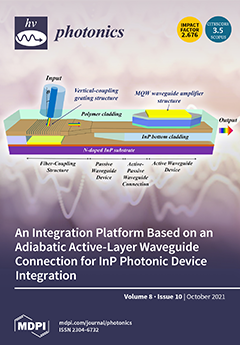This study proposes different fitting methods for different types of targets in the 400–900 nm wavelength range, based on convex optimization algorithms, to achieve the effect of high-precision spectral reconstruction for small space-borne spectrometers. This article first expounds on the mathematical model in
[...] Read more.
This study proposes different fitting methods for different types of targets in the 400–900 nm wavelength range, based on convex optimization algorithms, to achieve the effect of high-precision spectral reconstruction for small space-borne spectrometers. This article first expounds on the mathematical model in the imaging process of the small spectrometer and discretizes it into an
matrix equation. Second, the design basis of the filter transmittance curve is explained. Furthermore, a convex optimization algorithm is used, based on 50 filters, and appropriate constraints are added to solve the target spectrum. First, in terms of spectrum fitting, six different ground object spectra are selected, and Gaussian fitting, polynomial fitting, and Fourier fitting are used to fit the original data and analyze the best fit of each target spectrum. Then the transmittance curve of the filter is equally divided, and the corresponding
discrete equation set is obtained for the specific object target, and a random error of 1% is applied to the equation set to obtain the discrete spectral value. The fitting is performed for each case to determine the best fitting method with errors. Subsequently, the transmittance curve of the filter with the detector characteristics is equally divided, and the corresponding
discrete equation set is obtained for the specific object target. A random error of 1% is applied to the equation set to obtain the error. After the discrete spectral values are obtained, the fitting is performed again, and the best fitting method is determined. In order to evaluate the fitting accuracy of the original spectral data and the reconstruction accuracy of the calculated discrete spectrum, the three evaluation indicators MSE, ARE, and RE are used for evaluation. To measure the stability and accuracy of the spectral reconstruction of the fitting method more accurately, it is necessary to perform 500 cycles of calculations to determine the corresponding MSE value and further analyze the influence of the fitting method on the reconstruction accuracy. The results show that different fitting methods should be adopted for different ground targets under the error conditions. The three indicators, MSE, ARE, and RE, have reached high accuracy and strong stability. The effect of high-precision reconstruction of the target spectrum is achieved. This article provides new ideas for related scholars engaged in hyperspectral reconstruction work and promotes the development of hyperspectral technology.
Full article





